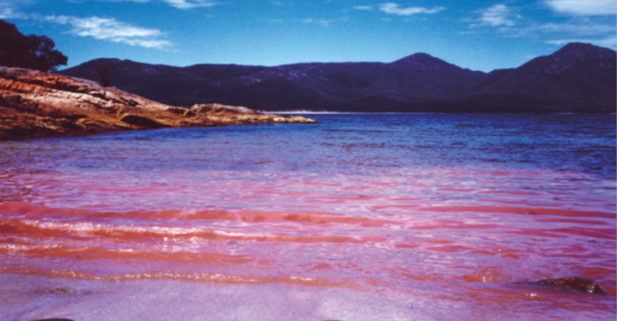Harmful algal blooms
by James Komisarjevsky, RJD intern
Harmful Algal Blooms (HABs) are something that affects almost every coastal region in the world. Many people know of the these HABs as red tides (Figure 1). These HABs not only affect coastal regions but have also been found to affect open ocean, brackish ecosystems, and freshwater ecosystems. Most of these HABs have been found to be caused by blooms of microscopic algae or by blooms of phytoplankton.

Figure 1. This figure depicts a red tide caused by an algal bloom. (Source: Erin Watson, University of Tasmania)
There has recently been an increase in the number of HABs due to an increase in a waters nutrient supply. An increase of nutrients such as nitrogen, phosphorous, silicate, and micronutrients can lead to a HAB. There is a concern today for the relationship between HABs and the increase of nutrient supply (eutrophication). Humans are a big component of the increase of nutrients because of sewage, groundwater and atmospheric inputs, and agriculture and aquaculture runoffs. When compared to preindustrial and preagriculture times, it has been estimated that phosphorous levels have increased three times in the world’s oceans. An example of this can be seen in China where there have been major changes in the quality of its coastal waters. Due to Chinas increasing populations and its rise in agriculture, there has been a fourfold increase of nitrate concentrations and a 30% increase of phosphate concentration in the past 40 years at the mouth of the Changjian River. The increase of nutrients due to humans has led to a significantly higher algal biomass and also a change in the phytoplankton community.A HAB is considered to be a concept rather than a scientific definition. There are certain criteria, which if met, an event is considered to be a HAB. The criteria contains causing injury to human health, causing socioeconomic interest, or changes certain components of an ecosystem. These HABs can cause illness or the deaths of marine organisms by the transfer of toxins through the food web (bioaccumulation). They can also cause an injury to human health due to the consumption of seafood which contain these toxins.
Climate change and overfishing have also caused concern for the increase of HABs. Prediction of the effects of climate change can only be speculated. This is because there is little long-term data of algal blooms for a specific region. Generally, at least 30 years of data is needed to establish trends on HABs. It is thought that some harmful species of algal blooms may become more prevalent while others may be negatively affected. Climate change will pose challenges for scientist because it is likely to cause changes in species composition, abundance, and the timing of HABS.
In recent years there has been an increase in the study ecogenomics and HAB species genes in order to further study HABs. Ecogenomics have caused interest because it gives scientist a way to study HABs and its surrounding ecosystem. This will allow for further information to be discovered about the consequences of HABs ecologically and their affect on other species evolutionarily. Also studying the genetics of HAB species will help scientist locate which genes are responsible for certain toxin production. This will help to classify the different species, which contain or do not contain the genes responsible for toxin production.
There is an increasing demand for the study of HABs and the species which cause them. Due to the anthropogenic affects such as eutrophication and overfishing, an increase in the number of HABs can have many affects on humans. Further and more studies of HABs will hopefully provide insight into helping us lower the numbers of HABs in the future.
REFERENCES
Anderson, Donald M., Allan D. Cembella, and Gustaaf M. Hallegraeff. “Progress in Understanding Harmful Algal Blooms: Paradigm Shifts and New Technologies for Research, Monitoring, and Management.” Annual Review of Marine Science 4 (2012): 143-76. Print.




We have a very simple solution to grow healthy Diatom Algae in any polluted / eutrophic waterway.
This prevents HABs and keeps the water clean and prevents eutrophication.